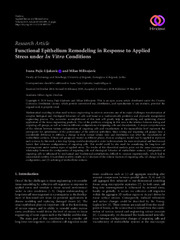Приказ основних података о документу
Functional Epithelium Remodeling in Response to Applied Stress under In Vitro Conditions
| dc.creator | Pajić-Lijaković, Ivana | |
| dc.creator | Milivojević, Milan | |
| dc.date.accessioned | 2021-03-10T14:04:16Z | |
| dc.date.available | 2021-03-10T14:04:16Z | |
| dc.date.issued | 2019 | |
| dc.identifier.issn | 1176-2322 | |
| dc.identifier.uri | http://TechnoRep.tmf.bg.ac.rs/handle/123456789/4210 | |
| dc.description.abstract | Mathematical modeling is often used in tissue engineering in order to overcome one of its major challenges: transformation of complex biological and rheological behaviors of cells and tissue in a mathematically predictive and physically manipulative engineering process. The successive accomplishment of this task will greatly help in quantifying and optimizing clinical application of the tissue engineering products. One of the problems emerging in this area is the relation between resting and migrating cell groups, as well as between different configurations of migrating cells and viscoelasticity. A deeper comprehension of the relation between various configurations of migrating cells and viscoelasticity at the supracellular level represents the prerequisite for optimization of the performance of the artificial epithelium. Since resting and migrating cell groups have a considerable difference in stiffness, a change in their mutual volume ratio and distribution may affect the viscoelasticity of multicellular surfaces. If those cell groups are treated as different phases, then an analogous model may be applied to represent such systems. In this work, a two-step Eyring model is developed in order to demonstrate the main mechanical and biochemical factors that influence configurations of migrating cells. This model could be also used for considering the long-time cell rearrangement under various types of applied stress. The results of this theoretical analysis point out the cause-consequence relationship between the configuration of migrating cells and rheological behavior of multicellular surfaces. Configuration of migrating cells is influenced by mechanical and biochemical perturbations, difficult to measure experimentally, which lead to uncorrelated motility. Uncorrelated motility results in (1) decrease of the volume fraction of migrating cells, (2) change of their configuration, and (3) softening of multicellular surfaces. | en |
| dc.publisher | Hindawi Ltd, London | |
| dc.relation | info:eu-repo/grantAgreement/MESTD/Integrated and Interdisciplinary Research (IIR or III)/46001/RS// | |
| dc.rights | openAccess | |
| dc.rights.uri | https://creativecommons.org/licenses/by/4.0/ | |
| dc.source | Applied Bionics and Biomechanics | |
| dc.title | Functional Epithelium Remodeling in Response to Applied Stress under In Vitro Conditions | en |
| dc.type | article | |
| dc.rights.license | BY | |
| dc.citation.other | 2019: - | |
| dc.citation.rank | M23 | |
| dc.citation.volume | 2019 | |
| dc.identifier.doi | 10.1155/2019/4892709 | |
| dc.identifier.fulltext | http://TechnoRep.tmf.bg.ac.rs/bitstream/id/10010/4892709.pdf | |
| dc.identifier.pmid | 31236134 | |
| dc.identifier.scopus | 2-s2.0-85072026457 | |
| dc.identifier.wos | 000470159700001 | |
| dc.type.version | publishedVersion |

